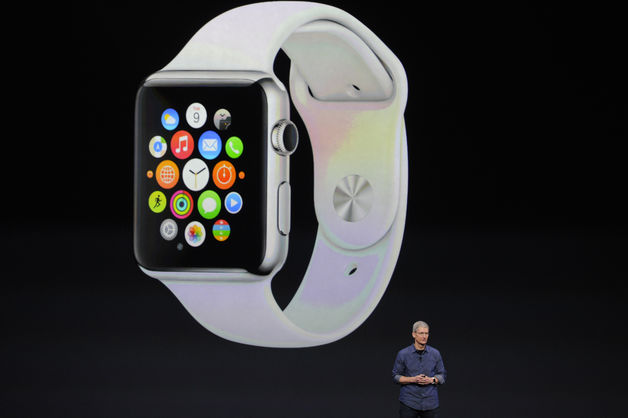The shortcomings of most personal fitness trackers are well-known: they’re clunky, have limited functionality and seem to only attract people who are already active, as opposed to sedentary people who want to slowly improve their health.
But if the launch presentation of Apple’s new Apple Watch turns out to deliver on its promises, it could inspire higher-level personal fitness (for those who can swing the $349 cost). According to Apple CEO Tim Cook, the new hardware will be insightful for professional athletes and weekend warriors and will even gently encourage us average Joes and Janes to take just a few more steps a day. That’s the hope, anyway.
With a built-in heart rate monitor, GPS for tracking your movement and accelerometer, the watch promises to track the intensity of your workouts, the number of steps you take, how far you went on your bike ride, and how many calories you burned. For those who don’t work out, a several other measures could help nudge you toward a healthier lifestyle. For instance, the Watch has certain built-in daily goals to help minimize sedentary time or fit in a certain number of steps.
To truly evaluate the Apple Watch’s performance, we’d have to get our hands on one, but that won’t be possible until early next year, according to Cook. But in the meantime, we’ve discovered some studies that do suggest the gadget’s features may be able to improve users’ health.
Keeping track of heart rate could make your workouts more efficient
To prevent weight gain, the intensity of exercise matters more than how long you do it, according to a 2013 study published in the American Journal of Health Promotion. Researchers from the University of Utah found that shorter, high-intensity bursts of exercise were linked to lower body mass indexes more than longer, more leisurely exercise. For example, every extra minute of high intensity exercise is linked with decreased obesity odds: five percent decreased odds for women and two percent for men.
Getting an hourly reminder to stand could help you counteract the ill effects of sitting all day.
Sad to say, but even daily exercise isn’t enough to stave off the negative effects of remaining completely sedentary the other 11 waking hours of your life, which include increased risk of cardiovascular disease and early death. To combat this, exercise scientists have recommended moving around for five minutes every hour, walking around the office every half hour, standing desks and walking desks. A gentle reminder to stand for one minute every hour seems like a good place to start.
Encourages even brisk walks, which can do more than you think.
The Centers for Disease Control and Prevention recommend that adults get at least 150 minutes of exercise every week, and that includes brisk walking. Yes, even just a humble brisk walk is all that it takes to keep your heart aerobically healthy — and it can even be done 10 minutes at a time, notes the CDC.
Helps you create and then achieve specific and tailored health goals.
If your goal is to “lose weight” or “get healthy,” you’ve got to get a bit more specific than that, according to the National Institutes for Health.
“Useful goals should be (1) specific; (2) attainable (doable); and (3) forgiving (less than perfect),” writes the NIH on their website. You’re more likely to achieve what you want with specific, measurable goals as opposed to ambitious or abstract wishes.
Could help you stay accountable by sending your exercise data to your friends.
Studies show that social networks and other forms of online support help people achieve their fitness goals. A recent analysis of 12 past studies on the subject found that the social networks’ effects were “modest but significant” in helping people lose weight, according to researchers from Imperial College London.
“The use of social media to treat obesity encourages patients to be more pro-active and empowers them to contribute towards their own treatment,” said lead author Dr. Hutan Ashrafian in a press release about the analysis. “It’s not the only solution to the obesity epidemic, but it should be introduced as an element of every country’s obesity strategy.”
Currently, you can get all five of these functionalities with other apps and wearables, but the promise of the Apple Watch is having it all in one sleek and streamlined gadget. Plus, we’re digging the different finish and strap options. Biometric data in a fashion-forward timepiece? Yes please.














